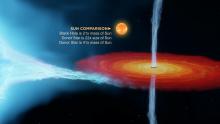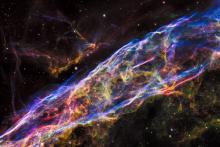Listen to today's episode of StarDate on the web the same day it airs in high-quality streaming audio without any extra ads or announcements. Choose a $8 one-month pass, or listen every day for a year for just $30.
You are here
Cygnus
One of the favorite constellations of summer soars high across the sky this month: Cygnus, the swan. It stretches across the east and northeast at nightfall. Its brightest stars form a pattern that really does look like a graceful swan, soaring through the glow of the Milky Way.
Its brightest star is Deneb, at the swan’s tail. It’s one of the most impressive stars in the galaxy — it’s far bigger, heavier, and brighter than the Sun.
But no less impressive is the star that marks the center of the swan, where its outstretched wings meet its long body. It’s called Sadr, a name that means “the hen’s breast.”
Like Deneb, it’s a supergiant. It’s about a dozen times as massive as the Sun, hundreds of times wider, and about 35,000 times brighter. That makes it easy to pick out even though it’s around 1800 light-years away.
Supergiants are the biggest and most massive of all the stars. They “burn” through their hydrogen fuel in a hurry, so they live short lives — in the millions of years, versus billions of years for stars like the Sun.
And when they die, they go out with a titanic explosion known as a supernova. And if the estimates of Sadr’s mass are correct, that’s exactly the fate that awaits it, sometime in the next few million years.
So look for Cygnus flying high across the sky tonight, with its brightest star, Deneb, at the northeastern point of the Summer Triangle. More about Cygnus tomorrow.
Script by Damond Benningfield






